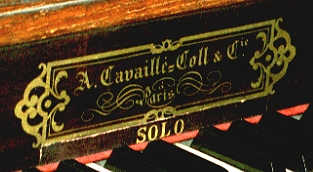  Nineteenth-Century France
|
| Review Quiz |
IntroductionThis is one of those rare instances where I can make such a bold statement without fear of contradiction.
Cavaillé-Coll was born in 1811 and worked first with his father, also an organ builder. After Rossini heard their work in Toulouse and encouraged the builders, Cavaillé-Coll visited Paris, made a proposal for a large new instrument at St. Denis, and won the contract. After that instrument was completed in 1841, examined by a state-appointed commission, and approved, Cavaillé-Coll won support from Napoleon III for the rebuilding of cathedral organs throughout France. The rest, as they say, is history. By the time of his death in 1899, his firm had built or rebuilt over 500 instruments, changing the nature of the organ in France for all time and establishing his name as a "household word" for generations of organists that have followed.174 Cavaillé-Coll worked as an organ builder for over fifty years, and it would be a mistake to think that all of his instruments -- large and small, from early and late in his career -- have exactly the same characteristics. You can expect to find changes in his style and even a gradual line of development in his work, just as you can in the works of a composer or any other artist. In the same way Bach's stylistic development was contained within the limits of style in the early eighteenth century, however, so was Cavaillé-Coll's development influenced by society, technology and musical style in France during the nineteenth century. Cavaillé-Coll's work as an organ builder needs to be understood as one aspect of musical life in post-revolutionary France. The audience formed by a growing and newly empowered middle class found their artistic ideals in works that were grandiose and powerful in their effect on the listener. The grand orchestral and choral works of Berlioz, in fact, come from the same fabric of society that championed the organs of Cavaillé-Coll. Both are products of the second quarter of the century that had their own effect on later composers and their music. During Napoleon III's "Second Empire," essentially the third quarter of the century, France saw considerable progress as it and virtually all of western Europe was affected by the Industrial Revolution. Just as the influence of Louis XIV had encouraged the wide-spread acceptance of the French Classical Organ,175 so did influential persons in nineteenth-century Paris give Cavaillé-Coll the support he needed to have his work accepted throughout all of France and even in other countries. Part of Cavaillé-Coll's success involves mechanical aspects of organ-building, while another is concerned with tonal properties of his instruments. You should realize that the two are not necessarily different; that is, tonal qualities of organs are at times dependent on mechanics. As you learn more about the details of Cavaillé-Coll's instruments, and as you look at some examples in detail, you will see how the mechanism affects the artistry of his organs. |
| Review Quiz |
copyright © 2000 AD James H. Cook